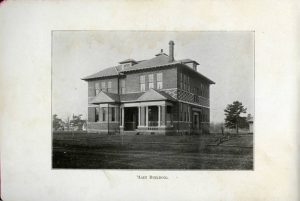calsfoundation@cals.org
Newly Digitized: Arkansas Military Academy Yearbook
One recent addition to the CALS Butler Center’s digital collection gives insight into the educational systems in Little Rock in the first years of the twentieth century. The Amazer Vol. I was the first yearbook, and perhaps the only yearbook, produced by the students of Arkansas Military Academy (AMA). This private school was established in Little Rock as a boys’ university training school in response to overcrowding and other problems in the public schools of the city.
 As page eight of the yearbook shows, plans for the academy began in the winter of 1901–1902 with a campaign for capital stock subscriptions. In April 1902, the stock company was formed and property was purchased. In May, building construction began. Included in the list of 135 subscribers on page nine is well-known Little Rock attorney Joseph W. House Sr., who served as president of the board of directors for the school. His two sons, Joseph W. House Jr. and Archie House, were students at the academy. The yearbook came into the Butler Center’s collection as part of the Archie F. House collection (BC.MSS.18.72).
As page eight of the yearbook shows, plans for the academy began in the winter of 1901–1902 with a campaign for capital stock subscriptions. In April 1902, the stock company was formed and property was purchased. In May, building construction began. Included in the list of 135 subscribers on page nine is well-known Little Rock attorney Joseph W. House Sr., who served as president of the board of directors for the school. His two sons, Joseph W. House Jr. and Archie House, were students at the academy. The yearbook came into the Butler Center’s collection as part of the Archie F. House collection (BC.MSS.18.72).
The Arkansas Military Academy was built at the corner of Gaines Street and 25th (now Roosevelt Road). Construction was completed in time for classes to begin on September 17, 1902. This main building, pictured on page two, was later supplemented by three barracks buildings, shown on page eighty-five.
Col. Robert C. Hall served as superintendent of the school and also taught mathematics and science. As photographs in the yearbook show, both students and faculty wore military-style uniforms and participated in regular drills. By the time this yearbook was published, the student body also included a group of students, described on page forty as sub-freshmen, made up of fourth, fifth, and sixth graders. Archie House’s name is on this list of students.
 Typical of such publications, the yearbook includes a history of the institution, rosters and photographs of the faculty and students, class prophecies, samples of creative writing by the students, and advertisements from community businesses. It also includes photographs of buildings, classrooms, the reading room, and sports teams. Athletics included football, basketball, tennis, and baseball.
Typical of such publications, the yearbook includes a history of the institution, rosters and photographs of the faculty and students, class prophecies, samples of creative writing by the students, and advertisements from community businesses. It also includes photographs of buildings, classrooms, the reading room, and sports teams. Athletics included football, basketball, tennis, and baseball.
Photographs in the yearbook are by Little Rock photographer George H. Roberts, whose ad on page ninety-six offers special rates to AMA students.
Eleven pages of advertisements promote groceries, clothing and furniture stores, financial services, photography, business classes, and others, all eager to serve the students and families of the Arkansas Military Academy.
The content of this yearbook looks to a bright future for Arkansas Military Academy and its students—a future that was not realized. Declining enrollment caused the academy to close after the end of the spring 1908 semester. The buildings were sold to the Catholic Diocese and became Little Rock College; today’s Catholic High School traces its history to this school. R. C. Hall later served as superintendent of the Little Rock School District, retiring in 1941. Today’s Hall High School is named for him. Thus, both the facilities and the people of the Arkansas Military Academy continued to play important roles in both public and private education in Little Rock.
The full digital content of this yearbook, as well as the finding aid for the Archie F. House collection, is available online here: https://arstudies.contentdm.oclc.org/digital/collection/p15728coll3/id/485674/rec/1
By Shirley Schuette, archival assistant, CALS Butler Center for Arkansas Studies




